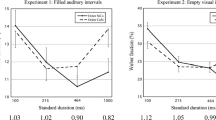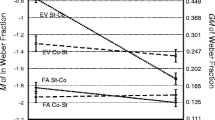Summary
Choice reaction time with two alternatives (optic and acoustic stimuli) was measured in an experiment with 24 subjects. Individual distributions for both modalities were plotted. From a total of 48 distributions 46 were multi-modal. The temporal difference between successive peaks had a mode value of 30 msec. For the interpretation of the results oscillatory processes are assumed. In a scanning model the hypothetical oscillations are independent of the stimuli. Such a model would predict only unimodal distributions. Since multi-modalities were observed, the data can best be accounted for by a model of excitability cycles.
Zusammenfassung
Die Reaktionszeit bei Wahlreaktionen mit zwei Alternativen (optische und akustische Reize) wurde bei 24 Versuchspersonen gemessen. Getrennt nach den beiden Modalitäten ergaben sich für jede Versuchsperson zwei Häufigkeits-Verteilungen der Reaktionszeit. In 46 der insgesamt 48 individuellen Verteilungen waren mehrere Maxima festzustellen. Der Abstand zwischen aufeinanderfolgenden Maxima in den Einzel-Verteilungen betrug 30 msec (Modalwert). Für die Deutung der Befunde werden hypothetische Oszillationen herangezogen. Es wird behauptet, daß multi-modale Verteilungen nur dann auftreten können, wenn die oszillatorischen Prozesse durch die Reize induziert werden. Eine reizunabhängige Oszillation („scanning“-Hypothese) kann unter den gegebenen experimentellen Bedingungen nur zu uni-modalen Häufigkeits-Verteilungen führen.
Similar content being viewed by others
References
Aschoff, J.: Zeitliche Strukturen biologischer Vorgänge. Nova Acta Leopoldina, N. F. 21, 147–177 (1959).
Augenstine, L. G.: Evidences of periodicities in human task performance. H. Quastler (ed.), Information theory in psychology, p. 208–226. Glencoe, Ill.: Free press 1955.
Baer, K. E. von: Welche Auffassung der lebenden Natur ist die richtige ? Und wie ist diese Auffassung auf die Entomologie anzuwenden ? „Reden St. Petersburg“, 237–284 Verlag d. kaiserl. Hofbuchhandlg. H. Schmitzdorff, 1864.
Barlow, J. S.: Evoked responses in relation to visual perception and oculomotor reaction times in man. Ann. N. Y. Acad. Sci. 112, 432–467 (1964).
Boynton, R. M.: Some temporal factors in vision. W. Rosenblith (ed.), Sensory communication, p. 739–756. New York: The MIT Press and Wiley 1961.
Christie, L. S., Luce, R. D.: Decision structure and time relations in simple choice behavior. Bull. math. Biophysics 18, 89–112 (1956).
Donders, F. C.: On the speed of mental processes. Acta psychol. 30, 412–431 (1969) (Orig. 1868).
Efron, R.: The duration of the present. Ann. N. Y. Acad. Sci. 138, 713–729 (1967).
Gooddy, W.: Disorders of the time sense. Handbook of clinical neurology, vol. 3, p. 229–250. (P. J. Vinken and G. W. Bruyn, eds.). Amsterdam: North-Holland Publ. Co. 1969.
Grüsser, O.-J., Grüsser-Cornehls, U.: Periodische Aktivierungsphasen visueller Neurone nach kurzen Lichtreizen verschiedener Dauer. Beziehungen zu den periodischen Nachbildern und dem Charpentier-Intervall. Pflügers Arch. ges. Physiol. 275, 292–311 (1962).
—, Grützner, A.: Neurophysiologische Grundlagen der periodischen Nachbildphasen nach kurzen Lichtblitzen. Albrecht v. Graefes Arch. Ophthal. 160, 65–93 (1958).
Häfner, H.: Psychopathologie der cerebralorganisch bedingten Zeitsinnesstörung. Arch. Psychiat. Nervenkr. 190, 530–545 (1953).
Harter, M. R.: Excitability cycles and cortical scanning: A review of two hypotheses of central intermittency in perception. Psych. Bull. 68, 47–58 (1967).
—, White, C. T.: Periodicity within reaction time distributions and electromyograms Quart. J. exp. Psychol. 20, 157–166 (1968).
Hoff, H., Pötzl, O.: Über eine Zeitrafferwirkung bei homonymer linksseitiger Hemianopsie. Z. ges. Neurol. Psychiat. 151, 599–641 (1934).
Kornblum, S.: Sequential determinants of information processing in serial and discrete choice reaction time. Psych. Rev. 76, 113–131 (1969).
Latour, P. L.: Evidence of internal clocks in the human operator. Acta psychol. 27, 341–348 (1967).
Laufer, M., Verzeano, M.: Periodic activity in the visual system of the cat. Vision Res. 7, 215–229 (1967).
Ornstein, R. E.: On the experience of time. Penguin, Harmondsworth 1969.
Pöppel, E.: Oszillatorische Komponenten in Reaktionszeiten. Naturwissenschaften 55, 449–450 (1968).
—: Oszillatorische Vorgänge in der menschlichen Zeitwahrnehmung. Irle, M. (Hrsg.), Bericht 26. Kongr. DGPs, p. 388–398. Göttingen: Dr. C. J. Hogrefe 1969.
- Aschoff, J. C., Giedke, H.: Tagesperiodische Veränderungen der Reaktionszeit bei Wahlreaktionen. Z. exp. angew. Psychol. (1970) (in press).
Smith, E. E.: Choice reaction time: An analysis of the major theoretical positions. Psychol. Bull. 69, 77–110 (1968).
Snodgrass, J. G., Luce, R. D., Galanter, E.: Some experiments on simple and choice reaction time. J. exp. Psychol. 75, 1–17 (1967).
Solomons, L. M.: Automatic reactions. Psychol. Rev. 6, 376–394 (1899).
Sternberg, S.: The discovery of processing stages: extensions of Donder's method. Acta psychol. 30, 276–315 (1969).
Stroud, J. M.: The fine structure of psychological time. Quastler, H. (ed.), Information theory in psychology, p. 174–205. Glencoe, Ill.: Free press 1955.
Wever, R.: Pendulum versus relaxation oscillation. Aschoff, J. (ed.), Circadian clocks, p. 74–83. Amsterdam: North-Holland Publ. Co. 1965.
Author information
Authors and Affiliations
Additional information
The author acknowledges the assistence of Dr. Ronald Chase with the preparation of the English version of this manuscript.
Rights and permissions
About this article
Cite this article
Pöppel, E. Excitability cycles in central intermittency. Psychol. Forsch. 34, 1–9 (1970). https://doi.org/10.1007/BF00422860
Received:
Issue Date:
DOI: https://doi.org/10.1007/BF00422860




